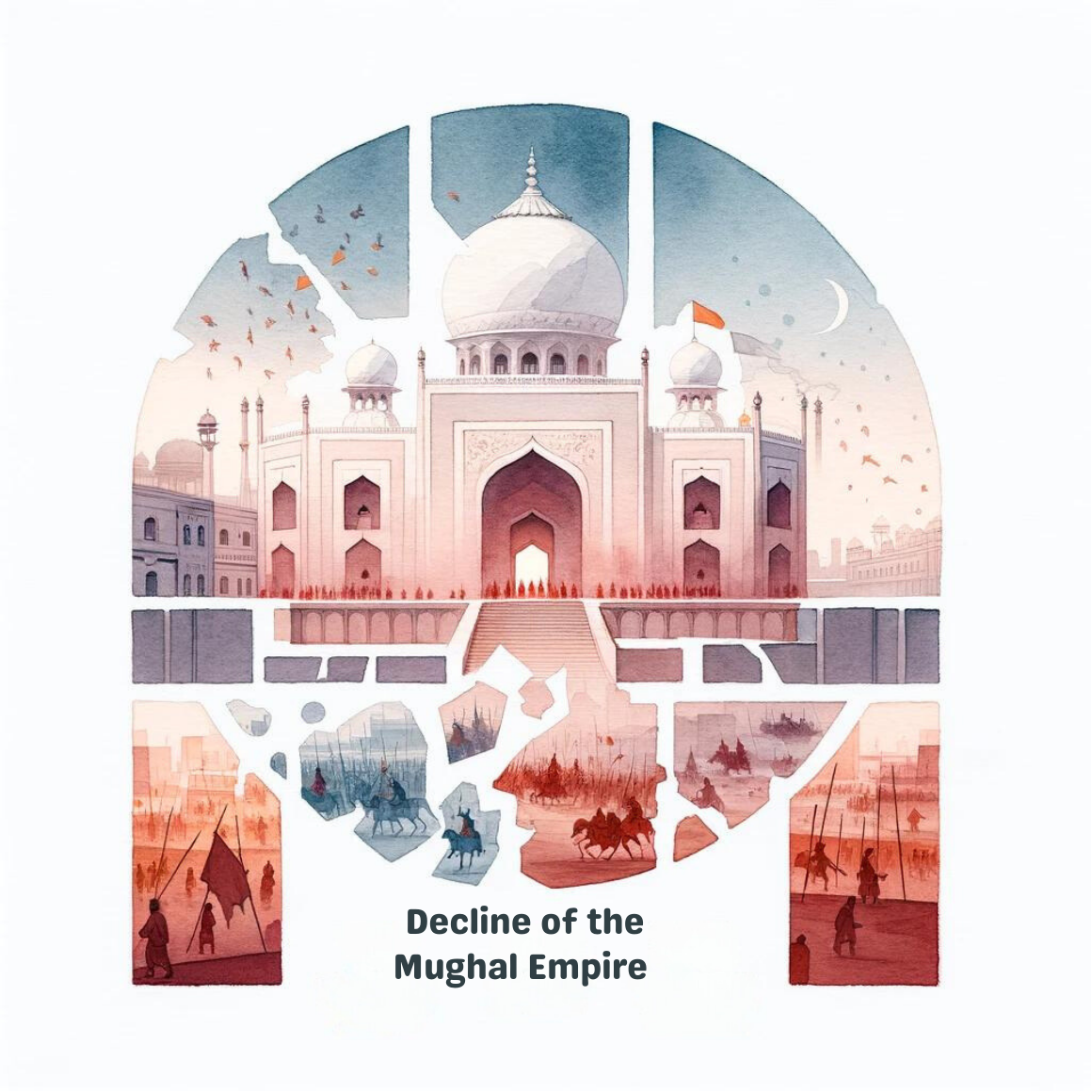The Mughal Empire, once a symbol of grandeur and power in the Indian subcontinent, experienced a gradual decline that led to its eventual collapse in the 18th century. This decline was not the result of a single cause but rather a combination of internal strife, administrative weaknesses, and external invasions. Understanding these factors and their consequences provides insight into a significant period in Indian history.

Causes of the Decline
- Weak Successors: After the death of Aurangzeb in 1707, the empire was left in the hands of weak and ineffective rulers. Aurangzeb’s successors lacked the strong leadership qualities necessary to manage the vast and diverse empire, leading to political instability and fragmentation.
- Administrative and Financial Issues: The Mughal administrative system, though sophisticated, became increasingly corrupt and inefficient over time. The jagirdari system was a system where nobles were granted land in exchange for military service. This led to exploitation and discontent among the peasantry. Additionally, the empire faced severe financial strain due to continuous military campaigns and lavish spending by the nobility.
- Military Decline: The Mughal military, once a formidable force, began to deteriorate due to a lack of funding, outdated tactics, and inferior weaponry. The empire struggled to defend its vast territories against both internal rebellions and external invasions.
- Religious and Social Policies: Aurangzeb’s religious intolerance, including the imposition of jizya (a tax on non-Muslims) and the destruction of Hindu temples, alienated a significant portion of the population. This religious intolerance fostered resentment and uprisings, weakening the empire from within.
- Rise of Regional Powers: Regional kingdoms and principalities such as the Marathas, Sikhs, and Rajputs began asserting their independence and challenging Mughal authority. The Marathas, in particular, emerged as a powerful force, conducting frequent raids into Mughal territories and sapping the empire’s strength.
- Foreign Invasions: The invasions by Nadir Shah of Persia in 1739 and Ahmad Shah Abdali of Afghanistan in the mid-18th century inflicted devastating blows to the Mughal Empire. Nadir Shah’s invasion led to the sacking of Delhi and the looting of immense wealth, further destabilizing the already weakened empire.
Consequences of the Decline
- Political Fragmentation: The decline of the Mughal Empire resulted in political fragmentation across the Indian subcontinent. Various regional powers and princely states gained autonomy, leading to a patchwork of competing kingdoms and a lack of centralized authority.
- Rise of the British East India Company: The weakening of Mughal power created a power vacuum that was gradually filled by the British East India Company. Initially focused on trade, the company increasingly involved itself in political and military affairs, eventually establishing control over large parts of India.
- Economic Impact: The breakdown of the Mughal administrative system and the continuous warfare disrupted agricultural production and trade. This economic instability led to widespread poverty and hardship among the common people.
- Cultural and Social Changes: The decline of the Mughals also led to significant cultural and social changes. As regional powers asserted their dominance, local cultures and traditions experienced a revival. However, the lack of a strong central authority also led to increased lawlessness and social unrest in many areas.
- Legacy of Mughal Architecture and Art: Despite their decline, the Mughals left behind a rich legacy of architecture and art that continues to be admired. Monuments such as the Taj Mahal, the Red Fort, and Humayun’s Tomb remain symbols of the empire’s former glory and its contributions to Indian culture.
Conclusion
The decline of the Mughal Empire was a complex process influenced by multiple factors. These factors include weak leadership, administrative inefficiencies, military decline, and external invasions. This decline had profound consequences for the Indian subcontinent, leading to political fragmentation, economic challenges, and the rise of British colonial power. Understanding the causes and consequences of the Mughal Empire’s decline provides valuable insights into the historical dynamics of India and the enduring legacy of one of its most significant empires.

